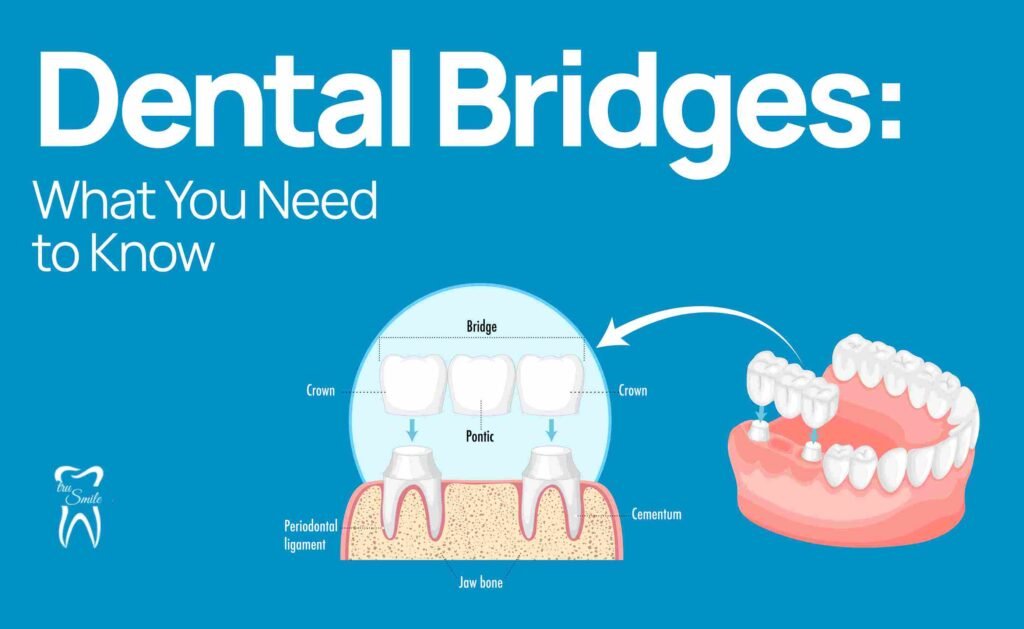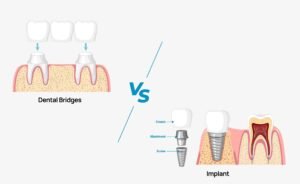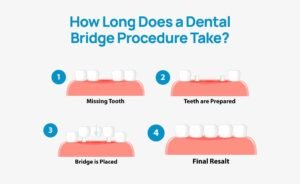Missing teeth can create multiple challenges. It can affect your appearance, speech, and cause issues with chewing. Many people are concerned about finding a practical, reliable solution to replace missing teeth.
Left untreated, missing teeth can shift other teeth out of place. This leads to further dental issues. It can also affect self-confidence and impact overall oral health. If it is left untreated, it may lead to the need for a lot of expensive and painful procedures to be fixed in the future.
Dental bridges are one of the most effective solutions to restore your smile, oral function, and confidence. Various types of dental bridges are available to suit a variety of different needs, which can suit everyone.
Let’s see these things in detail, starting from the basic knowledge!
What are Dental Bridges?
A dental bridge is a prosthetic tooth. It may be made of porcelain, ceramic, or metal. It is designed to fill the gap left by a missing tooth. There are attachments on both sides of the gap that hold the bridge in place. The process got its name from this link, which acts like a bridge.
Dental bridges not only restore the aesthetics of a complete smile but also help maintain a proper bite and prevent shifting of teeth. A bridge typically consists of two parts:
Abutment Teeth
Abutment teeth are the natural teeth on either side of the missing tooth gap that support the bridge. The abutment teeth hold the dental bridge in place and make sure it works properly.
Pontic
The pontic is the false tooth that fills the gap of the missing tooth or teeth. It is positioned between the abutment teeth. Pontics also restores the appearance and function of natural teeth. They are typically made from ceramic or porcelain and are designed to match surrounding natural, healthy teeth.
Dental Bridge vs. Implant: Which is Better?
It is important to think about things like cost, durability, and personal preference when choosing between a dental bridge and an implant.
Dental bridges are generally more affordable. They require shorter treatment times compared to implants. So, they are an appealing choice for those looking for a quicker solution. However, bridges may require reshaping of supporting, natural, healthy teeth to provide stability to the bridge and replacement or repair after every 5–15 years.
Dental implants, on the other hand, involve surgically placing a titanium post in the jawbone. It then serves as an anchor for a replacement tooth. Implants are more durable and can last a lifetime with proper care, but they are more expensive and take more time to put in. Implants are ideal for those who seek a more permanent solution and can undergo a surgical procedure.
Common Types of Dental Bridges
There are four main types of dental bridges. Dental professionals use specific bridges based on your oral health needs. The main types of dental bridges are:
1. Traditional Dental Bridge
The traditional dental bridge is the most commonly used type. It includes crowns on both ends, with pontics (artificial teeth) filling the gap between. The crowns (also known as abutments) are bonded to healthy natural teeth on either side of the gap to hold the bridge in place.
Traditional bridges are ideal when you have strong natural teeth on both sides. They provide excellent support. This type is effective for restoring function and appearance. Particularly in areas that undergo significant chewing forces.
2. Cantilever Bridge
A cantilever bridge resembles a traditional bridge but it has only one abutment (crown) instead of two. The bridge “extends” over the missing tooth gap. It is attached solely to one side. Dentists recommend cantilever bridges when only one healthy natural tooth is available for support.
They are not as stable as regular bridges due to their design. They work best in places where no one bites down hard. Excessive pressure on a cantilever bridge can affect the supporting tooth so dentists carefully assess its placement.
3. Maryland Bridge
Maryland bridges (also known as resin-bonded bridges) secure the bridge using metal or porcelain “wings” instead of crowns. These wings are bonded to the backs of the adjacent teeth. Its procedure is less invasive since there’s no need to reshape the surrounding teeth.
Maryland bridges are most suitable for replacing front teeth due to their lightweight design but they are not good for molars or back teeth because they can not handle chewing hard food. This type preserves tooth structure and is a great option for patients with minimal tooth loss in visible areas.
4. Implant-Supported Bridge
An implant-supported bridge combines traditional bridging techniques with dental implants. It uses implants instead of natural teeth for support.
Implants are small posts. These are used to replace the roots of missing teeth. Implants must be fully healed before a bridge can be attached to them. Usually, this process takes three to six months. The bridge is fixed on top once healing is complete.
This type of bridge is particularly useful for patients with three or more missing teeth in a row. It provides a durable solution that doesn’t depend on adjacent natural teeth for support. Although the procedure takes longer due to the healing process, it offers lasting stability and comfort.
How Long Does a Dental Bridge Procedure Take?
The dental bridge procedure typically involves two or three appointments. This can be done in a span of two to three weeks. Here’s a step-by-step look at what the process includes:
1. Initial Consultation and Preparation
During the first visit, the dentist evaluates your oral health. He takes x-rays and discusses options for different bridges. In traditional bridges, the dentist changes the shape of the teeth that hold the bridge in place so that crowns can be fitted.
2. Impressions and Temporary Bridge
After prepping, the dentist makes an impression of the teeth. Which will serve as a model for the permanent bridge. When the permanent bridge is being designed, a temporary bridge is placed to protect the prepped teeth.
3. Fitting and Adjustments
Once the permanent bridge is ready, the dentist fits and adjusts it as needed. It typically takes 1-2 weeks. The proper fitting of a bridge is important for comfort, functionality, and durability.
4. Final Placement
The dentist cements the bridge in place. Then he makes any last adjustments to ensure it fits well and feels comfortable.
Remember!
The overall time may vary based on:
- The type of bridge
- Number of missing teeth
- Implants are involved or not
- Patients health conditions
Tips to Maintain a Dental Bridge for Longevity
It is important to take care of a dental bridge so that it lasts and works well. Here are some tips to help prolong the life of your bridge:
Practice Good Oral Hygiene
Brush your teeth twice daily with fluoride toothpaste. Floss at least once a day. Pay extra attention to cleaning under the pontic (especially with traditional bridges) using a floss threader or an interdental brush.
Avoid Hard Foods
Biting down on hard foods like ice, candies or sticky food can damage or dislodge the bridge. Try eating a balanced diet with softer foods.
Regular Dental Check-Ups
Dentists say that you should see them every six months to make sure that the bridge stays in place and that the teeth and gums around it are healthy.
Address Any Issues Promptly
If you notice discomfort, sensitivity, or movement in the bridge, visit your dentist promptly. Early intervention can prevent more complex and costly repairs.
What is the Success Rate of Dental Bridges?
Studies show that dental bridges have a high success rate. The traditional bridges can last between 5 and 15 years. The implant-supported bridges last even longer.
According to research by Parkwood Dental, the five-year success rate of traditional dental bridges is around 95% and with proper care, some can last up to 10–15 years or more.
Final Thoughts
Dental bridges offer a reliable and functional solution for missing teeth. These have multiple types tailored to specific needs. A traditional bridge for a quick fix. An implant-supported bridge for a long-term fix. You should carefully consider your choices based on things like cost, durability, and personal preference before choosing any treatment.
Dental bridges are a cost-effective way to restore your smile and dental function. If you take good care of them, they can give you years of comfort and confidence.
Consult with your dentist to find the best option available for you and maintain your bridge to ensure a healthy, functional smile for years to come.



